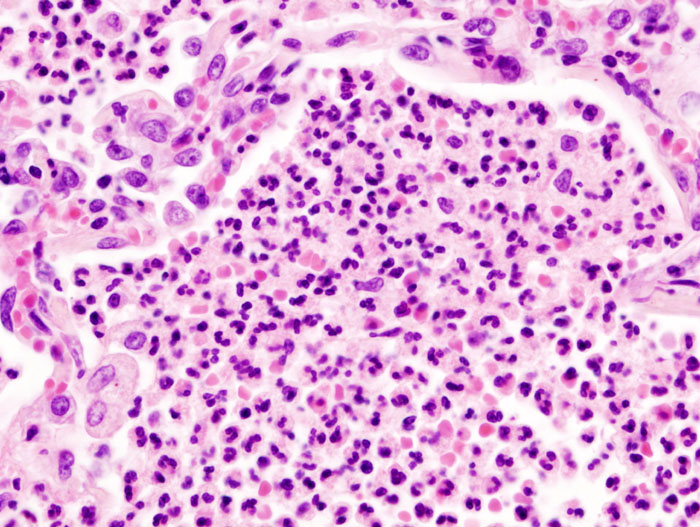 Tomorrow (November 12) is World Pneumonia Day. Although it seems that there’s a commemorative event almost every day to increase awareness about various illnesses or health issues, pneumonia is one that the world should remember and take action on. Pneumonia is currently the number one killer of children worldwide, more than HIV/AIDS, malaria, and measles combined.* Furthermore, 98% of children who die from pneumonia come from developing nations. Current efforts to curb deaths from pneumonia include vaccination drives, increasing the use of community health workers to observe and administer antibiotics to sick children (after the findings in a new study), supporting exclusive breastfeeding (PDF), and decreasing indoor air pollution, such as smoke from wood-burning stoves. In 2008, 18% of deaths of children under five were caused by pneumonia (PDF). An article in The Huffington Post by Dr. Orin Levine has the basic facts on pneumonia and is worth a read, and the Kaiser Family Foundation has a round-up of articles on pneumonia and World Pneumonia Day if you want to learn a little more. A progress report recently released by the International Vaccine Access Center (IVAC) discusses the achievements and shortcomings of efforts to curb pneumonia and deaths from the disease. Although vaccination efforts are underway in developing and developed countries alike, access to antibiotics and adherence to exclusive breastfeeding are still challenges in lower-income settings.
Tomorrow (November 12) is World Pneumonia Day. Although it seems that there’s a commemorative event almost every day to increase awareness about various illnesses or health issues, pneumonia is one that the world should remember and take action on. Pneumonia is currently the number one killer of children worldwide, more than HIV/AIDS, malaria, and measles combined.* Furthermore, 98% of children who die from pneumonia come from developing nations. Current efforts to curb deaths from pneumonia include vaccination drives, increasing the use of community health workers to observe and administer antibiotics to sick children (after the findings in a new study), supporting exclusive breastfeeding (PDF), and decreasing indoor air pollution, such as smoke from wood-burning stoves. In 2008, 18% of deaths of children under five were caused by pneumonia (PDF). An article in The Huffington Post by Dr. Orin Levine has the basic facts on pneumonia and is worth a read, and the Kaiser Family Foundation has a round-up of articles on pneumonia and World Pneumonia Day if you want to learn a little more. A progress report recently released by the International Vaccine Access Center (IVAC) discusses the achievements and shortcomings of efforts to curb pneumonia and deaths from the disease. Although vaccination efforts are underway in developing and developed countries alike, access to antibiotics and adherence to exclusive breastfeeding are still challenges in lower-income settings.
What this progress report and World Pneumonia Day illustrate, along with every other “disease day,” is that health routinely takes a back seat to other issues that require funding and global attention, especially when the countries bearing the brunt of a disease burden are low-income or don’t hold strong international influence. Like the prevention of polio, TB, or malaria, pneumonia requires targeted, though not necessarily expensive, interventions. Pneumonia also suffers from lack of public awareness–HIV, for example, gets much more press coverage. I’d wager that if polled, most people would guess that HIV and not pneumonia is the number one killer of kids in developing nations. This is not to say that HIV treatment and prevention efforts do not require more investment; on the contrary, they are woefully underfunded, as are most global health interventions. As I’ve written too many times before, more funding is needed, which looks unlikely in the current global climate. One day, perhaps, the world will wake up and realize that the right to health and equitable access to health care are as vital to economic development, strong societies, and good governance as every other human right. Advocates must carry on pressing for more funding for global health, even if such arguments proceed to fall on deaf ears. For now, those working in global health organizations must continue to use existing funding to develop, implement, and prove the efficacy of simple, low-cost health interventions: a rapid test, a trained community health worker, or a shot in the arm.
*It’s unclear however, how certain cases of HIV and pneumonia are separated–it’s a common opportunistic infection for newborns who are HIV-positive, which is why a newborn whose mother has HIV should be administered the antibiotic Cotrimoxazole as a pneumonia prophylactic before their own serostatus has been determined.
Header photo, of aspiration pneumonia, by KGH, CC BY-SA 3.0.